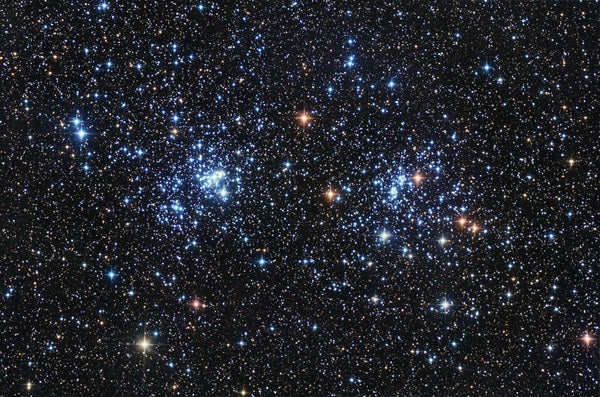Known since the earliest days of naked-eye astronomy, the Double Cluster in Perseus appears in the star catalog of Greek astronomer Hipparchus in 130 B.C. The two clusters are now designated h and Chi (χ) Persei (NGC 869 and NGC 884, respectively) and look like nebulous 4th-magnitude stars. One of astronomy history’s real mysteries is why Charles Messier listed the Pleiades (M45) and the Beehive (M44) clusters, but not the Double Cluster, in his catalog of non-cometary objects — oops! The earliest use of the Double Cluster moniker seems to be George F. Chambers’ 1867 edition of Descriptive Astronomy.
Finding the Double Cluster is only challenging when light pollution is significant. Locate Epsilon (ε) and Delta (δ) Cassiopeiae and look southeast about 50 percent farther than the gap between those stars. Even with some light pollution, the Double Cluster should be visible in a finder scope or binoculars.
About 7,500 light-years away, these are some of the most distant naked-eye star clusters. The light you’re seeing today comes from a time about 3,000 years earlier than the pyramids in Egypt, just as humans first began smelting copper in the Neolithic period and before the invention of the wheel.
The Double Cluster certainly defines “rich” in terms of star fields. Even the smallest telescopes easily resolve both clusters. Yet larger apertures don’t overwhelm the view. Increasing magnification will push one of the clusters out of the field, but its stars are simply replaced by more in the single cluster left.
Both clusters contain young, hot stars sprinkled in with red supergiants like Antares and Betelgeuse. The color contrast of blue and red — observable in many clusters with varying difficulty — is ridiculously easy here. Whether you are using a 3-inch lens or a 12-inch mirror, NGC 869 and NGC 884 are an amazing sight that will impress non-stargazing friends in the backyard after a barbecue.
Make sure to explore Astronomy’s full list of 101 cosmic objects you must see. New entries will be added each week throughout 2022.
To get the latest astronomical news and observing content delivered directly to your door, subscribe to Astronomy magazine today!










